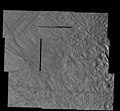Fil:PIA01633 Tyre impact structure Europa.jpg

Storleik på førehandsvising: 666 × 599 pikslar. Andre oppløysingar: 267 × 240 pikslar | 533 × 480 pikslar | 853 × 768 pikslar | 1 138 × 1 024 pikslar | 2 540 × 2 286 pikslar.
Opphavleg fil (2 540 × 2 286 pikslar, filstorleik: 1,28 MB, MIME-type: image/jpeg)

Følgjande er henta frå filomtalen åt denne fila på Wikimedia Commons:
Filhistorikk
Klikk på dato/klokkeslett for å sjå fila slik ho var på det tidspunktet.
| Dato/klokkeslett | Miniatyrbilete | Oppløysing | Brukar | Kommentar | |
|---|---|---|---|---|---|
| gjeldande | 22. februar 2020 kl. 11:38 |  | 2 540 × 2 286 (1,28 MB) | User-duck | Cropped using CropTool with lossless mode. |
| 14. mars 2010 kl. 00:53 |  | 2 686 × 2 494 (1,28 MB) | WolfmanSF | {{Information |Description={{en|1=This mosaic shows the Tyre multi-ring structure which is thought to have been formed by a large impact onto Jupiter's moon Europa. The effective crater (large bull's-eye feature) is about 40 kilometers (25 miles) across w |
Filbruk
Den følgjande sida bruker denne fila:
Global filbruk
Desse andre wikiane nyttar fila:
- Bruk på af.wikipedia.org
- Bruk på de.wikipedia.org
- Bruk på en.wikipedia.org
- Bruk på fr.wikipedia.org
- Bruk på ko.wikipedia.org
- Bruk på mt.wikipedia.org
- Bruk på no.wikipedia.org
- Bruk på ro.wikipedia.org
- Bruk på ru.wikipedia.org

